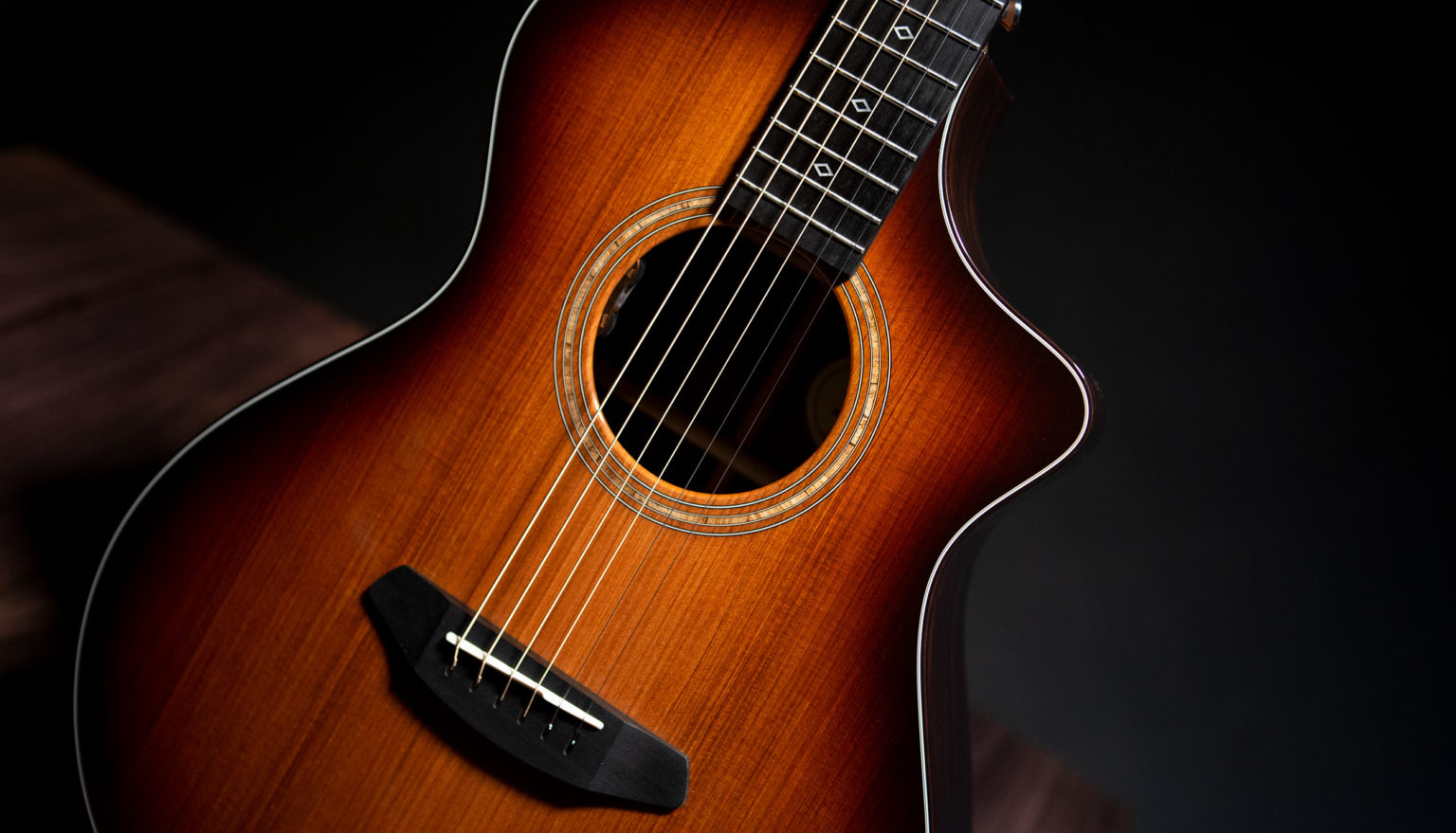
 Hey everyone! My name is Chris Arndt, and I’m the guitar-wielding half of sibling rock act Jocelyn & Chris, as well as Breedlove’s Featured Artist for the month of May! If you’re into blues, or rock, or guitars, or badass vocalists named Jocelyn, you can listen to some of our stuff here (or on your streaming platform of choice; we’re on them all).
Hey everyone! My name is Chris Arndt, and I’m the guitar-wielding half of sibling rock act Jocelyn & Chris, as well as Breedlove’s Featured Artist for the month of May! If you’re into blues, or rock, or guitars, or badass vocalists named Jocelyn, you can listen to some of our stuff here (or on your streaming platform of choice; we’re on them all).
If you’ve been paying attention to Breedlove for a while, you might remember me from such blog posts as Pairing Breedlove Guitars with Beer, or Pairing Breedlove Guitars with Bread, or Pairing Breedlove Guitars with Cocktails. I’ve been Breedlove’s Featured Artist twice before, because I really like Breedlove guitars. I also really like beer, bread, and cocktails. Sadly, you can only pair Breedlove guitars with carbs and beverages so many times before you just have to admit that you’re getting redundant. That’s why, this month, I’ll be focusing my blogs on something completely different, totally new, and revolutionary to the Breedlove blogosphere: wine.
Just kidding. We’re going to talk about how experimenting with different guitars has changed the way I write music.
I’m the proud owner of three beautiful Breedlove guitars. That, combined with Jocelyn’s two Breedloves and our communal Breedlove ukulele, means two things. First, the square footage of our apartment is, like, at least 20% Breedlove instruments. Second, I’m lucky enough to talk about how playing varied instruments brings out totally different attributes of my songwriting.
Not everyone has the option of picking which of their multiple guitars they feeling like playing at the moment. I’m not trying to be that guy. “Hey everyone! Come see how many amazing guitars I own!” Having a plethora of guitars to play is pretty new for me, and I’m not saying everyone has to have three different guitars to make music.
If you’re reading this and thinking “Man, now I gotta go out and buy more guitars”, well, you might be right, but I really don’t want to give the impression that you need a lot more guitars. They’re kind of like the knives in your kitchen. Sure, it’s nice to have a chef’s knife, and a cleaver, and a set of paring knives, and a bread knife, and a tomato knife, and all the other special-purpose knives you can think of. But really, you’ll get a lot further with one good knife that you like using than you will with a massive collection of lesser ones. I like to grab the guitar that matches my vibe because I can, but I haven’t always had a collection of guitars to choose from, and Jocelyn and I wrote plenty of interesting and diverse songs back when I only owned one acoustic!
Playing and writing with a variety of instruments, however, has had some interesting impacts on my music, and I wanted to explain that process in a bit more depth.
Using different instruments makes me think and play differently, but until I sat down to write this piece, I’d never really considered how or why. After some meditation (and maybe an IPA or two), I figured out a slightly more logical and systematic way of breaking this down. Guitars have three main characteristics that impact the way I write music with them: the way the guitar sits, the way the guitar sounds, and the way the guitar feels. So, now that I’ve thrown some terminology at you, let’s look at exactly what ‘sit’, ‘sound’, and ‘feel’ mean!
For context, my Breedloves are: a Performer Concerto Bourbon CE from the Organic Collection, a Pursuit Exotic S Concert, and a Pursuit Exotic S Concertina.
The ‘sit’ of a guitar is the least abstract of the three, so it seems like the place to start. Think about the ways your body physically interacts with the instrument. In other words, the guitar’s ergonomics. This includes things like:
- where the guitar rests in your lap
- how comfortable the guitar feels to you
- how your picking arm naturally falls over the body
- where your fingering arm naturally rests on the neck
- the angle of your fingering wrist
That’s not even close to a comprehensive list of the ways your body physically interacts with a guitar. Still, it should get you thinking in the right direction!
When I sit down to write a new chord progression or riff, I rarely have any kind of plan, so the ‘neutral resting position’ of the guitar can have a big effect on what I end up playing. If the angle of my fingering hand lands naturally on the lower strings, I’ll likely end up working on something with power chords or a low riff. Alternatively, if the same angle makes it more comfortable to play on the higher strings, I might instead lean into melodic playing with bright, full chords or arpeggiation. Depending on where my right hand falls, I might play with more strumming and less picking, or vice versa. Where my left hand falls in the neck will likely determine the register I play in, etc etc. You can play any guitar part on any guitar, but if you’re just sitting down to mess around, the way the guitar sits can direct your playing.
Onto the ‘sound’ of a guitar. This is probably the most self-explanatory idea of the three. When I talk about a guitar’s ‘sound’, I basically just mean its tonal characteristics. For me, having an instrument with a sound you like is the most important part of being able to write music. It might be inconvenient, but I can definitely work around guitars that sit or feel awkward. If the sound isn’t inspiring me, however, it just doesn’t work. Luckily, all of my guitars sound amazing, so I’m never really in that situation!
My guitars also all sound very different from one another, because they all have different Breedlove body shapes. (Note: If you’re not familiar with the pioneering body shapes that Breedlove makes, check out the video in that link.) I love having those options because the different sounds inspire me in different ways. My Performer Concerto (Breedlove’s version of a Dreadnaught), for example, has this amazingly rich, darkish tone, which makes it really dramatic and inspiring when working on slow chord progressions in minor keys. I’ve found that the Concertina (Breedlove’s version of a Parlor) is really well-suited to minimal, bright playing—think “Here Comes the Sun” or “The Rainbow Connection”. It also has a growly chunkiness on the low strings that makes it super fun to play power chord riffs on. I like using my Concert (Breedlove’s original shape, comparable to an OM or Auditorium) to work on faster strum patterns or more difficult chordal arrangements, though it really does everything awesomely. That one is kinda my main squeeze.
Finally, let’s talk about the ‘feel’ of a guitar. This is really just a term I came up with to cover all of the hand-wavey space between a guitar’s sit and a guitar’s sound. It’s the je ne sais quoi, or the special sauce, or the local flavor, or however else you can think of saying it. Different guitars just feel different, and while the way it sits with you and the way it sounds are a part of that, there’s more to the story that just can’t really be put into words. I’ve noticed that if I’m feeling angsty, I really like bashing out big, chunky chords on my Concerto. I’ve also noticed that I prefer playing the Concertina when it’s raining out and I’m alone. I don’t know why, but the guitars just feel right in those situations.
It’s difficult to describe how a guitar’s feel affects the way I write music, but if a guitar feels right for the moment, I stop thinking and just play. Getting ‘lost in the music’ makes writing feel effortless. That’s always my goal, to tap into a direct experience where the guitar and I both disappear, leaving just the music. Sometimes, though, it actually helps to have an instrument that feels less natural. If I’m trying to work out the timing of a complex riff or chord progression, I don’t want to be lost in the music; I want to be paying close attention to every note and strum, and considering whether they’re working in the context of the whole piece. Getting lost in the playing feels great, and you can come up with some amazing ideas in that space, but it also makes the details of playing feel hazy and distant.
To be honest, I’ve never organized my thoughts about how different guitars impact my creativity before. Framing and scaffolding the ways that different instruments shape my playing and writing has forced me to think more critically about my relationships to my different guitars. That’s an idea that has always seemed so obvious that I’d never actually thought about it in depth before.
My takeaway is this: play lots of different guitars. I’m not saying you should necessarily buy lots of different guitars. I mean, if you can afford them, by all means. But if you’re a serious player, you probably have access to various instruments of different shapes from different manufacturers. Instead of just picking them up and assessing them (Do I like this guitar? Is it better than my guitar? Should I have bought this guitar instead?) assess yourself and how that guitar affects the way you approach making music.
I hope you enjoyed reading it as much as I enjoyed writing it, and don’t forget to check out Jocelyn & Chris online!
